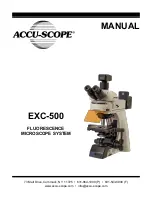
©
Home Training Tools Ltd. 2013 Page 3 of 8
Visit us at ww.homesciencetools.com
level, while the longest has the highest. The
lenses have the following features:
They are
achromatic
–
they
help
prevent color distortion.
They are
parcentered
– if you center
your slide using one objective, it will
still be centered when you move to
another objective.
They are
parfocal
– if you focus your
specimen using one objective, it will
stay coarsely focused when you move
to another objective. (You will still
have to make minor adjustments.)
The 40x objective is
retractable
– the
tip containing the lens is spring-
loaded to prevent damage to the
objective or slide.
5.
Stage
: The stage is the platform that supports
the specimen slide below the objective lenses.
It moves up and down when you turn the
focus knob, allowing you to get just the right
distance between the slide and the lens.
6.
Stage stop
: This is a screw with a lock nut
located between the stage and the arm of the
microscope. It prevents the stage from coming
too far up and grinding against the objective
lens. It is
also called a “safety rack stop,” and
is
pre-adjusted
by
the
manufacturer.
Instructions for readjusting it manually are on
page 4.
7.
Stage clips
: The stage clips hold microscope
slides in place. Pressing on the end closest to
the arm of the scope will lift up the other end,
allowing you to place your slide underneath.
8.
Disc diaphragm
: The diaphragm controls the
amount of light coming through the specimen
in order to provide optimum resolution for the
objective lens. The diaphragm on this
microscope is a rotating disc under the stage
with holes that are numbered by size; for
example, a hole labeled 6 is 6mm in diameter
and a hole labeled 2 has a diameter of 2mm.
Use the smaller holes for lower magnification
and the larger holes for higher magnification.
9.
Focus knob:
The focus knob is used to raise
or lower the stage until the image is in focus.
The focus mechanism uses a slip clutch to
prevent damage to the gears.
10.
Illuminator:
The illuminator provides light
underneath the stage. The MI-1100STD
contains a 15-watt tungsten bulb. The MI-
1100LED contains an LED bulb and light
intensity control knob located on the base.
This intensity control helps adjust illumination
contrast. Instructions for changing the bulbs
are on page 4.
Power Options for MI-1100LED
The LED Microscope comes with a built-in
rechargeable NiMH battery and charger. The fully
charged battery provides about 15 hours of totally
portable microscope use. The AC adapter is used
to recharge the battery. (The battery should be
fully charged before first use, or use the adapter.)
Red and green lights on the back of the
microscope indicate charging status. Please
follow these charging guidelines to maintain
maximum battery life for your microscope.
1. Turn off the illuminator and plug in the AC
adapter.
2. A red light only indicates the battery is
charging and has less than 70% of full charge.
3. Both a red and green light indicates the
battery is charging and has 70-90% of charge.
4. A green light only indicates the battery is fully
charged and ready for use.
5. Typical charging time is 4-8 hours. Do not
charge the battery or leave the AC adapter
plugged in for more than 12 hours.
Operating Procedure
Now that you have an overview of what each
component of your microscope is for, you can
follow this step-by-step procedure to help you get
started using it.
1. Set your microscope on a table or other flat
surface where you will have plenty of room to
work. Plug the microscope’s power cord into
an outlet, making sure that the excess cord is
out of the way so no one can trip over it. (The
MI-1100LED also operates on battery power.)
2. Flip the switch to turn on your microscope's
light source and then turn the disc diaphragm
to the largest hole, which allows the greatest
amount of light through. (You will adjust this
again later for best contrast.) The MI-
1100LED also has a light intensity control on
the base: turn the intensity up fully.
3. Rotate the nosepiece to the lowest-power
(4x) objective. You will hear a click when it is
properly in place. Always start with the lowest
power: it is easiest to scan a slide at a low
setting, as you have a larger field of view.


























